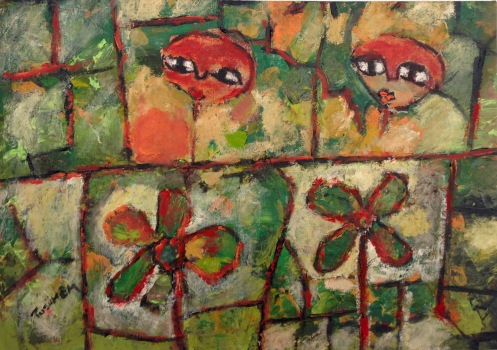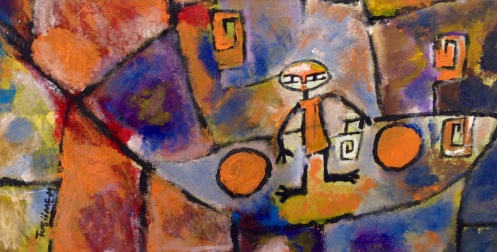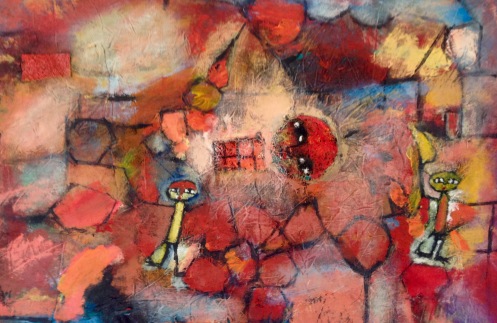Mathias Tusiime – Art and the Community
The raw energy in Tusiime’s paintings – compelling and revealing.
By George Kyeyune
Writing about Tusiime the artist is one
of the most challenging things I have ever done. Tusiime is a
combination of defiance and compliance- one can say in a sea of
ambivalences, he has blossomed as one of Uganda’s best-known painters.
He arrived at Makerere in 1999 to fill a post of a cleaner. His job was
to clean and organize the studios and as he carried out these tasks, he
was, at personal level, organizing and nurturing his artistic ambition.
He interacted with art students and professors, observed, appreciated
and respected their thoughts and processes but audaciously chose his own
path and with compulsion pursued it. An experimental and naïve painter
is now his badge of identity proudly displayed on his sleeves. Local and
international collectors have acquired his work, art colleges in
America and elsewhere have invited him to share his unique and
individual experience and skills.
Tusiime arrived at a time the Makerere
School of Industrial and Fine Arts was increasingly becoming more open
minded and accommodative to alternative viewpoints. The earlier
curriculum had stringently subscribed to academic rules of perspective,
color theory and anatomy, moreover operating within a critical vacuum
and without clear locally defined evaluative criteria. Such conditions
could have locked out painters such as Tusiime. In the new dispensation,
a stage was set for new perspectives in art some of which returned us
to Trowell’s legacy. Trowell founded the Makerere Art School in the 40s
with a mission of preserving what was relevant in the African cultural
past and most of this was to be found in the rural subject matter.
A major retrospective exhibition of Jack Katarikawe Dreaming in Pictures
at the Makerere Art Gallery in 2005 was a stark reminder of Trowell’s
teaching philosophy. Katarikawe’s paintings can be characterized as
naïve, loaded with humor and fantasy; stories are intrinsic to the
picture- cows speak and behave like humans. Katarikawe’s artistic
development was fostered in the late 60s at Makerere but outside the
Makerere Art School. This was expected as his painting represented
neo-traditional sensibilities, a reminder of Trowell, which the teaching
system at the time did not favor. His triumphant return to Makerere Art
School four decades later, demonstrated a new stance of inclusion and
accommodation of multiple viewpoints. Little wonder, Tusiime felt safe
and confident to pursue his ultimate goal as his ideas matched those of
Katarikawe.
Remaining impervious to observation
drawing and paying no attention to anatomy and perspective, Tusiime’s
work draws on his childhood memories, which he paints with spontaneity
and candor. Animals, plants and rural Uganda architecture are recurring
motifs that crowd his canvases. His figures look out and gaze as if to
challenge the observer. Tusiime’s distinctiveness is in the application
of materials. He paints on hand made paper canvas which he himself makes
by converting waste that he cleans up such as discarded paints, paper,
which he combines with sugar cane pulp, hence contributing to the
ongoing debate about application of indigenous materials in art at the
School.
I must emphasize that, the wide range of
exposure to different possibilities in art notwithstanding, Tusiime
chose to follow Trowell’s path- a path which I argue is also pandered to
by the Western audience and collectors. They desire and are prepared to
pay for a certain kind of art that in some way conveys and connects
with traditions inherited from the past; an ‘authentic’ African artist
expressing naivety in African art. While I take naïve painting as
legitimate in its own right, what I see happening as in this particular
context unfortunately, is to perpetuate Western stereotypes of an
African artist, lacking in sophistication and a continued emphasis on
the notion of ‘the other’.
Yet Tusiime’s paintings are of no less
value just because they are conceived within the scope of Trowell’s
teaching agenda. As a matter of fact, one of Tusiime’s major
breakthroughs in the recent past is the knowledge transfer partnership
he has established with the local communities. His experiments with
paper production from recycled materials as well as painting from his
heart have been shared with young often unemployed people of Kalerwe a
poor neighborhood in the outskirts of Kampala. As well as realizing
themselves through art, Tusiime’s protégés are able to earn an income
from the sale of their work.
Just like his career, which emerged from
obscurity to prominence, Uganda Community Art Skills Development and
Recycling (UCSADR) an organization Tusiime created to support local
communities using art, is set to become a formidable institution for
poverty alleviation. What is more, Tusiime’s project is also stressing
the need to clean up the environment through recycling.
Tusiime’s exhibition in the Makerere
Institute of Heritage Conservation and Restoration is a proof of his
resilience and tenacity. It is about a man who is prepared to overcome
obstacles and take art to new directions and heights. He is confident
and determined.
Follow the link below
https://makerereartgallery.wordpress.com/2015/07/30/mathias-tusiime-art-and-the-community-2/



No comments:
Post a Comment